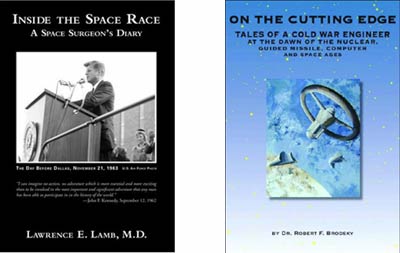|
|
Review: more tales from the Space Age
by Jeff Foust
Monday, January 8, 2007
Inside the Space Race: A Space Surgeon’s Diary
By Lawrence E. Lamb, M.D.
Synergy Books, 2006
hardcover, 424 pp., illus.
ISBN 1-933538-39-2
US$20.95
On the Cutting Edge: Tales of a Cold War Engineer at the Dawn of the Nuclear, Guided Missile, Computer and Space Ages
By Dr. Robert F. Brodsky
Gordian Knot Books, 2006
softcover, 216 pp., illus.
ISBN 1-884092-62-4
US$18.00
There continues to be a small but notable niche in the publishing world of memoirs from those have participated in space exploration in one manner or another, particularly in the golden era of the 1950s and ’60s. However, by now nearly all of the major actors, from astronauts and engineers to politicians and bureaucrats, have either already told their stories or are no longer around to do so. This leaves more minor players to tell their parts in the development of the space program in the US. As two recent books demonstrate, these tales may not be as profound, but they can still be interesting.
In Inside the Space Race, Lawrence Lamb recounts his time at the Air Force’s School for Aerospace Medicine in San Antonio from the mid-1950s through the mid-60s. Lamb, a cardiologist, was initially recruited to ensure that Air Force pilots didn’t suffer from heart ailments, but later became involved in the medical evaluation of astronaut candidates. It was a career that he said he stumbled into quite by accident: “I just happened to be sitting on the rocket when the fuse was lit—by the Soviets.”
One of the biggest roles he played was in the medical disqualification of Mercury astronaut Deke Slayton, and the internal controversy that generated. In September 1959 Slayton was sent to Lamb to investigate a recent case of an irregular heartbeat during a centrifuge test. Lamb found that it was not caused by a viral infection, as had been suspected (or hoped for), but was a case of atrial fibrillation that would disqualify Slayton from flight duty. Much of Lamb’s book recounts the saga that followed as NASA tried to minimize the consequences of the diagnosis and find alternative medical opinions that would allow Slayton to fly, in the process creating friction between some in the new space agency and Lamb.
| Neither Brodsky nor Lamb were major players in America’s race to the Moon or other aspects of the Space Age, but that doesn’t mean that they don’t have some interesting stories to tell. |
Another interesting aspect of the book is the discussion of the strong relationship Lamb had with Lyndon Johnson. Lamb first met Johnson in the late 1950s, when the then-senator, a political patron of the medical center, visited the facility and had Lamb create a pocket-sized record of his most recent electrocardiogram, something Johnson was quite fond of. Johnson visited the center on a number of occasions thereafter, including after become vice president, and Lamb became a part of his circle of friends, with frequent trips to LBJ’s Texas ranch.
Bob Brodsky didn’t ground a Mercury astronaut or become fast friends with the vice president, but in On the Cutting Edge he describes a long and varied career in engineering, including work on a number of space projects. The book is comprised of a number of anecdotes from his career, from graduate school through retirement. Those tales includes stories of work on rockets and satellites while with Aerojet in the 1960s, research and teaching experiences as a professor at Iowa State University in the ’70s, and more space projects at TRW in the ’80s.
Among the book’s highlights was the work he performed in the early 1960s to design a lifeboat, featuring inflatable structures and a parawing, for a space station then on the drawing boards for circa 1970. It turns out that it was an idea ahead of its time both then and more recently, as Brodsky discusses his efforts to generate interest in the concept for use on the ISS in the last decade. More successful was a later effort to recognize astronautical engineering as an academic discipline independent of aeronautical or aerospace engineering.
Neither Brodsky nor Lamb were major players in America’s race to the Moon or other aspects of the Space Age, nor do they claim to be in the books. However, that doesn’t mean that they don’t have some interesting stories to tell from that era in history. For those curious to learn more about that time—and even share a laugh or two—both Inside the Space Race and On the Cutting Edge offer some enlightenment and entertainment.
Jeff Foust (jeff@thespacereview.com) is the editor and publisher of The Space Review. He also operates the Spacetoday.net web site and the Space Politics and Personal Spaceflight weblogs. Views and opinions expressed in this article are those of the author alone, and do not represent the official positions of any organization or company, including the Futron Corporation, the author’s employer.
|
|
